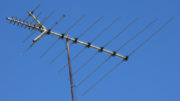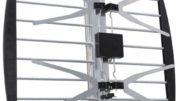It’s Labor Day and we’re here trying to talk shop with installers. We’re not referring to professional antenna installers. Today’s their much-earned day off. We’re reaching out to all you do-it-yourself installers instead. Maybe you’re not quite ready for the super-high-end stuff you’ll find in this week’s email. You’re probably more of the “weekend warrior” type of installer who might take advantage of this work holiday to put up a new antenna on your roof. We want to help you stay safe when you’re up on that roof. As you’ll find out, there is one huge potential danger up there and it’s NOT falling off the roof. (But that’s bad too.)
Overhead Wires Can be Deadly!
While falling off the roof is a concern, overhead wires are much more dangerous. Power, telephone, and cable TV lines carry immense amounts of power. If you accidentally touch one of them with your body or a conductive object, like a TV antenna, you’ll likely get electrocuted and even die. This is why the safety tips we’re about to share with you are so vital.
Here’s the most important thing we can tell you: if one of these wires is touching your antenna, stop right there! Do not attempt to remove the antenna yourself. There could be a massive amount of electricity traveling through that old antenna. There’s no way you could remove it without getting a tremendous shock. In these dangerous situations, we recommend you call the power company so they can send a technician out to remove it.
Ladder Safety Tips for Installers
If the overhead wires aren’t contacting your antenna, you can remove it yourself. There are still some very important safety precautions you need to take, though. These tips start before you get up on the roof. Here are some basic ladder safety tips for anyone planning to get up on their roof to install or remove an antenna:
- Since electricity is involved, it’s best to use a fiberglass ladder instead of one that’s made of metal.
- Check your ladder for damage. Replace any damaged ladders with new ones.
- Make sure your ladder’s feet work properly and have slip-resistant pads.
- Set your ladder up in a safe place with a solid footing and strong support.
- Set your ladder at the angle recommended by the ladder maker.
- Make sure your ladder extends three feet above the landing.
- When climbing up or down, keep one hand and both feet, or both hands and one foot, on the ladder at all times.
- Don’t carry anything that’s so heavy or big that you lose balance.
- Do not stand on top of the ladder. Also, don’t pull, stretch, or make sudden movements when you’re on it.
- Set your ladder up away from doors and paths.
Avoiding Overhead Wires
So, you’ve safely climbed on top of the roof and it’s time to install or remove that antenna. Now what? It’s time to take notice of those overhead power lines mentioned earlier in this post. If you’re body touches these wires, you could receive a very serious shock. In many cases, it has been fatal. Since antennas are made of metal and other conductive materials, you could suffer a fatal shock if you antenna makes contact with these power lines.
Here are some tips to help you avoid striking, touching, or make contact with overhead power lines:
- Make sure to put your ladder as far away from the power lines as possible so those wires aren’t near you when you climb on top of the roof.
- Be sure to be aware of the location of all the power lines at all times when you’re on the roof.
- Do not install the antenna at night. (These power lines tend to be black, which makes them hard to see in the dark.)
- Don’t install an antenna during bad weather conditions. (This helps avoid slip-and-fall injuries and lightning strikes.)
- Assemble your antenna after you climb atop the roof. (Trying to carry and antenna up a ladder could create a falling hazard. It’s all too easy to accidentally hit a wire while you’re carrying a fully-assembled antenna.)
- Don’t run your downlead cable over power lines.
- When you’re done with your installation, make sure to check for the power line location before you go to leave. (It’s dangerously easy to forget about those live wires because you’re eager to get off the roof and be done with the installation.)
Antenna Grounding: It’s Just as Important
Staying safe on the roof is a big part of the job but it’s not the only one. Protecting your home against lightning that can strike an antenna is a big part of it, too. Lightning strikes can cause surges that can destroy your computer and other electrical systems. These strikes can also cause house fires. There are ways to protect your home and everyone in it from these situations. There’s only one way to do that, and that’s to make sure that your outdoor antenna installation is properly grounded.
Before you try to ground your installation, you have to make sure you you’re doing it right according to your area’s rules. Grounding ordinances are different according to each city, county, and state. You need to make sure you know exactly how you’re area expects you to ground your installations. There’s only one way to do this, and that’s by going down to your city planner’s office or city hall. Once you know what you’re municipality expects, you can use our grounding guide for your installation.
Your DIY Antenna Installation Source
So, are you planning on getting up on the roof to install an antenna? We’ve already made it pretty clear that Solid Signal wants to help keep you safe. In addition to the tips we’ve shared, we also carry plenty of grounding equipment and safety gear to help you stay safe. For example, we have ground clamps, ground blocks, and other devices used to ground a variety of antenna installations. We also carry a variety of safety gear you can use when you’re on the roof.
There are many ways that Solid Signal can help you with your installation. One of these ways is making sure you have everything you need before you get on the roof. This includes making sure you know the proper steps for installing these devices and have everything you need. Before you set foot on that ladder, you should give us a call at 888-233-7563. This might be the only time you install an antenna, so we want to make sure you do it right!





